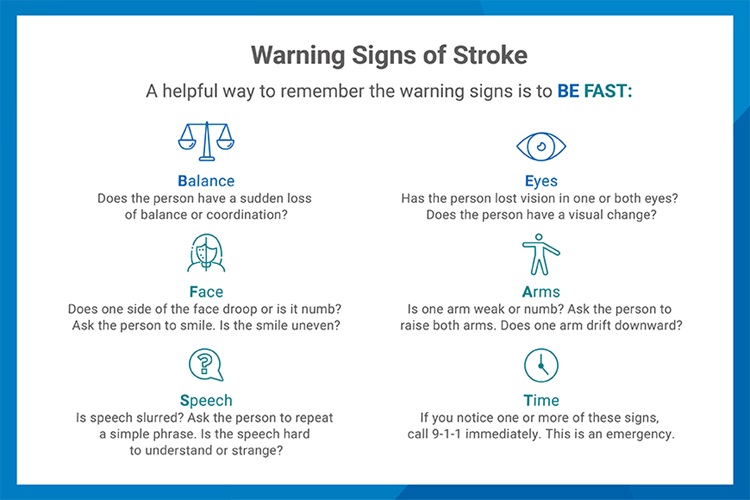Stroke Awareness
Emergency treatment focused on your recovery
Stroke Awareness at Winchester Hospital
Winchester Hospital is a designated Primary Stroke Service Hospital by the Massachusetts Department of Public Health. This means that emergency diagnostic and therapeutic services are available 24 hours a day.
About Stroke
Minutes matter when dealing with a stroke. Stroke is the third-leading cause of death in the United States and the first-leading cause of disability. At Winchester Hospital, our rapid response and expert intervention staff have the resources to provide care.
Similar to a heart attack, a stroke is a “brain attack” – an interruption of blood flow to the brain. There are two types of stroke:
- Ischemic stroke, the most common type, happens when a blood vessel in the brain becomes blocked by a clot or cholesterol buildup and cuts off blood flow to the brain.
- Hemorrhagic stroke happens when a weakened or bulging wall of a blood vessel in the brain gives way, causing bleeding within the brain.
A stroke is a serious emergency. When you come to Winchester Hospital, our team will provide you with the best care. Should you require more specialized treatment, we will quickly and efficiently transfer you to another facility for that care.
It’s vital to know the warning signs of stroke and what you can do to reduce your risk of stroke.

A helpful way to remember the warning signs is to BE FAST:
- Balance – Does the person have a sudden loss of balance or coordination?
- Eyes – Has the person lost vision in one or both eyes? Does the person have a visual change?
- Face – Does one side of the face droop or is it numb? Ask the person to smile. Is the smile uneven?
- Arms – Is one arm weak or numb? Ask the person to raise both arms. Does one arm drift downward?
- Speech – Is speech slurred? Ask the person to repeat a simple phrase. Is the speech hard to understand or strange?
- Time – If you notice one or more of these signs, call 9-1-1 immediately. This is an emergency.
Stroke has three treatment pathways: prevention, immediately after a stroke, and post stroke.
- Prevention treatment is about controlling your risk factors for stroke. Some risk factors such as age and family history can’t be controlled, so controlling the risk factors you have an influence over will lessen your chances of having a stroke to begin with.
- Immediately after a stroke, we have a short window of opportunity to be able to administer medication that will quickly dissolve the clot that is causing the stroke and/or remove the clot through a procedure called a thrombectomy. It is so important that since we only have this small window of opportunity to treat to call 9-1-1 if you have one or more symptoms of a stroke as soon as they occur. Do not hesitate!
- Post stroke, our primary goal is prevention of a reoccurrence by controlling the risk factors that may have contributed to the stroke. Rehabilitation is also a consideration to help the survivor regain strength, movement, and/or speech.
- High Blood Pressure – High blood pressure is the most important risk factor for stroke. Work with your doctor on a plan to lower your blood pressure. It may include taking medications as prescribed, watching your diet, quitting smoking and getting regular exercise.
- Tobacco Use – Tobacco use doubles the risk for another stroke. If you smoke, try to quit. Work with your healthcare provider if you need help.
- High Cholesterol – Cholesterol that builds up in the arteries can block normal blood flow to the brain. This can cause a stroke and also increases the risk of heart disease. Work with your doctor to keep your cholesterol levels in a healthy range.
- Diabetes – People with diabetes are up to four times more likely to have a stroke. By controlling your diabetes, you can help lower your risk of stroke.
- Atrial Fibrillation – Atrial fibrillation (a type of abnormal heart rhythm) increases your stroke risk five times, so it’s important to work with a doctor to control it. Most people have to take a blood thinner to do so.
- Diet – Eat a healthy diet. Watch the amount of calories, saturated fat, trans fat, cholesterol and salt intake. This will help you manage your weight and cholesterol levels in your blood, which also can reduce the risk for stroke.
- Physical Activity – Physical activity reduces the risk of stroke. Try to increase your physical activity and get some exercise each day.
- Alcohol Use – Drinking too much alcohol may increase your blood pressure and risk of stroke. Alcohol can also affect how certain medications work. Talk with your doctor to learn whether drinking is safe for you and how much is too much.
If you think you could be at risk for having a stroke, please call your healthcare provider.
Please Remember: If you think you or someone else is having a stroke, immediately call 9-1-1. If possible, note the time symptoms began.
